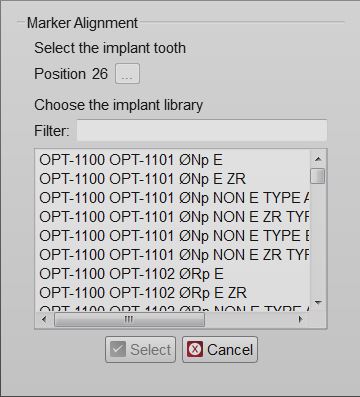Difference between revisions of "Man ImplantAlign/pt-br"
| Line 44: | Line 44: | ||
The acquired marker mesh will need to be aligned to the library marker shape. From this data the connection position will be computed. | The acquired marker mesh will need to be aligned to the library marker shape. From this data the connection position will be computed. | ||
| − | + | Este procedimento tem de ser realizado para cada implante do projeto. O [[Man_DataExport|CAD Export]] irá emitir um aviso se um ou mais alinhamentos de implantes estão faltando. | |
{{Navigation|Man_MeshEditing|Man_DataExport}} | {{Navigation|Man_MeshEditing|Man_DataExport}} | ||
Revision as of 09:07, 5 February 2016
Marker Acquisition
When acquiring the data for a project on implants, acquiring the implant itself is problematic. It's not like a stump or a piece of stone model. The implant connections/interfaces are normally small and metallic.
Além disso, o encaixe tem que ser mecanicamente perfeito, sem margem de erro.
To solve this problem, the implant connection is not directly scanned but an Implant Marker or Scan Body is used in its stead. A Scan Body is a specific object, designed to be scanned, which fits exactly over the implant.
The scan of the implant marker itself is not enough: its resulting data will be used to compute the exact position of the implant interface. In order to carry out this operation, an Implant Library is needed .
O alinhamento com a biblioteca de implante pode ser realizada no software CAD. No entanto, usando uma biblioteca de implantes para a Plataforma de Exocad, o usuário pode executar essa operação diretamente no software de escaneamento OpticalRevEng Dental, a fim de obter melhores resultados.
Seleção de Implantes
After the mesh generation, by selecting the mesh of an implant marker from the project tree, the Marker Alignment button will appear in the Main Toolbar. Click on this button to open the Implant Selection dialog.
In this Dialog there are:
- Uma seleção da posição dos dentes (o botão com três pontos ...) que podem ser usados apenas em Free Mode para selecionar a posição de um implante dentário
- Uma lista de implantes com todos os implantes disponíveis na atual Biblioteca de Implantes
- Uma caixa de filtro, onde é possível escrever parte do nome do implante necessário. Todos os implantes que correspondem ao nome serão mostrados na lista de implantes
Selecione o implante a ser utilizado e clique no botão Selecione .
Atenção ao escolher o implante correto da biblioteca. Muitas bibliotecas de implantes têm diferentes versões de cada conexão implante. Por exemplo:
- Engaging Connections : the connection can not rotate on the implant, suggested for abutments or single restorations
- Not-Engaging Connections : the connection can rotate on the implant, suggested for bars and bridges
- For Zirconia : connections with specific shapes, suited for zirconia restorations
Se o implante errado for selecionado, é possível repetir o procedimento para substituir a antiga conexão alinhada com uma nova.
'Se o desenho CAD é lançado usando uma conexão errada, será necessário reiniciar todo o projeto desde o início'
Marker Alignment
Ao selecionar a conexão de implante, o software irá iniciar o modo Alinhamento Manual .
The acquired marker mesh will need to be aligned to the library marker shape. From this data the connection position will be computed.
Este procedimento tem de ser realizado para cada implante do projeto. O CAD Export irá emitir um aviso se um ou mais alinhamentos de implantes estão faltando.



